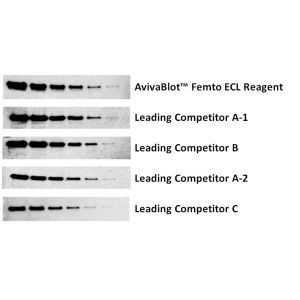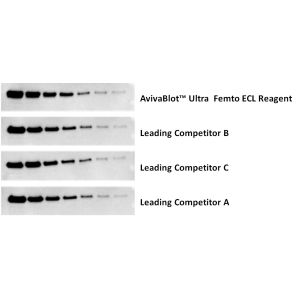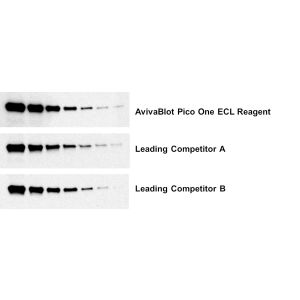Anti-Fibrillarin (Nop1p)
Referencia OAPC00110
embalaje : 100ul
Marca : Aviva Systems Biology
| Datasheets/Manuals | Printable datasheet for OAPC00110 |
|---|
| Predicted Species Reactivity | Human, Rat, Drosophila, C elegans, S pombe, Plant |
|---|---|
| Product Format | Liquid. 10mM NaN3 |
| Clonality | Monoclonal |
| Clone | 38F3 |
| Isotype | IgG1 |
| Host | Mouse |
| Application | WB, IF |
| Reconstitution and Storage | Store at -20°C in undiluted aliquots; stable for at least 1 year. Avoid freeze/thaw cycles. |
| Immunogen | Yeast nuclear preparations. |
| Concentration | Varies by lot. See vial for concentration. |
| Specificity | Specific for the ~34kDa Fibrillarin /Nop1p protein in Western blots of human, rat, plant, Drosophila, C. elegans and S. pombe. It is expected that it will work on other mammal tissues. |
| Application Info | WB 1:1000 IF 1:500 |
| Reference | 1. Ochs RL, Lischwe MA, Spohn WH, Busch H. Fibrillarin: a new protein of the nucleolus identified by autoimmune sera. Biol Cell 54:123-133 (1985). 2. Aris JP and Blobel G. Identification and characterization of a yeast nucleolar protein that is similar to a rat liver nucleolar protein. J. Cell Biol. 107:17-31 (1988). 3. Newton K, Petfalski E, Tollervey D, Caceres JF. Fibrillarin is essential for early development and required for accumulation of an intron-encoded small nucleolar RNA in the mouse. Mol Cell Biol. 23:8519-8527 (2003). 4. Tyagi S and Alsmadi O. Imaging native beta-actin mRNA in motile fibroblasts. Biophys J. 87:4153-62 (2004). 5. Paeschke1 K, Simonsson T, Postberg J, Rhodes D, Lipps H-J. Telomere end-binding proteins control the formation of G-quadruplex DNA structures in vivo Nature Structural & Molecular Biology 12, 847-854 (2005). 6. Vermaak D, Henikoff S, Malik HS. Positive selection drives the evolution of rhino, a member of the heterochromatin protein 1 family in Drosophila. PLoS Genetics 1:96-108 (2005). |
|---|---|
| Gene Symbol | NOP1 |
| Alias Symbols | LOT3 |
| NCBI Gene Id | 851548 |
| Protein Name | rRNA 2'-O-methyltransferase fibrillarin |
| Description of Target | Nop1p was originally identified as a nucleolar protein of bakers yeast, Saccharomyces cerevisiae. The Nop1p protein is 327 amino acids in size (34.5kDa), is essential for yeast viability, and is localized in the nucleoli (1). The systematic name for S. cerevisiae Nop1 is YDL014W, and it is now known to be part of the small subunit processome complex, involved in the processing of pre-18S ribosomal RNA. Nop1p is the yeast homologue of a protein found in all eukaryotes and archea generally called fibrillarin (2). Fibrillarin/Nop1p is extraordinarily conserved, so that the yeast and human proteins are 67% identical, and the human protein can functionally replace the yeast protein. Patients with the autoimmune disease scleroderma often have strong circulating autoantibodies to a ~34kDa protein which was subsequently found to be fibrillarin. Recent studies show that knock-out of the fibrillarin gene in mice results in embryonic lethality, although mice with only one functional fibrillarin/Nop1p gene were viable (3). This antibody is becoming widely used as a convenient marker for nucleoli in a wide variety of species (e.g. 4-6). |
| Uniprot ID | P15646 |
| Protein Accession # | NP_010270.1 |
| Molecular Weight | ~34kDa |







